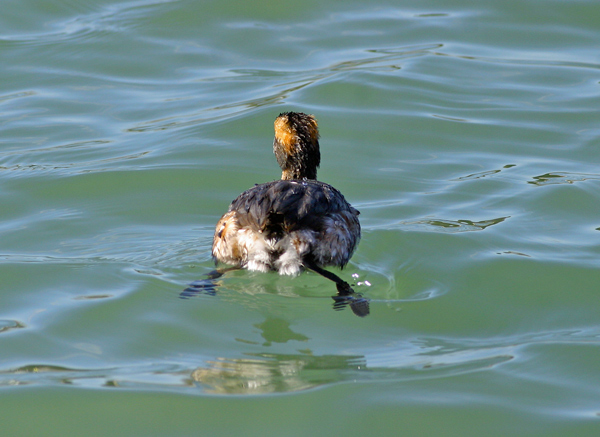A horned grebe (Podiceps auritus) makes a rare appearance at Ashbridge’s Bay last week. © BCP
It’s taken me a while to find the time to post my most recent images of some delightful creatures I saw last weekend, but here they are, finally.
Above is a grebe, of course, but what kind?
When I saw it last weekend, diving about at Ashbridge’s Bay, I was startled and simultaneously thrilled. I visit the park often and only rarely have I seen a grebe there. Since I do see them so infrequently, my knowledge of these ducklike divers (known as podicipeds) is negligible. When I saw this pint-sized diver and his mate (at least I surmised it was his mate), I was unsure. Did his golden ear patch and blazing red eyes mean he was an eared grebe? Or did his red neck make him a — what else? — a red-necked grebe?
Consulting my guides at home, it was immediately obvious. My unknown diver was neither an eared grebe (Podiceps nigricollis) nor a red-necked grebe (Podiceps grisegena), but a horned grebe (Podiceps auritus). Only one species of grebe in my books had all three characteristics of my specimen: red eyes, red neck and and golden ear patch. It had to be a horned grebe. Oh. One other thing. Eared grebes and red-necked grebes have completely black bills. My specimen had a black bill tipped with white.
To begin to fill in my knowledge gaps about grebes, I had to do a wee bit of reading.
Grebes belong to the avian order Podicipediformes (and family Podicipedidae). I read somewhere online that the their order and family names derive from Latin roots meaning “feet at the rear.” But before accepting this holus bolus — we all know how one piece of misinformation can get passed along so many times online that it can become indistinguishable from the truth — I decided to do more research. I searched up and down the Internet’s Latin translators, trying to establish the veracity of the claim. Certainly, I already knew that the “ped” in the name came from the Latin “pes” for foot. But what about “podici”?
The feet of a horned grebe, way way at the back of his body, showing the toes. © BCP 2011
I spent some time riffling through a Latin/English dictionary — a large, dusty tome that looked like it might have last been used when Julius Caesar was a boy. No dice. I mean, no “podici.” I found nothing that looked a bit like the Latin “podici” to explain this bird’s order.
But then I tried a staggeringly huge English-only dictionary (it’s as big as a bar frig and as dusty as the one that’s been in your garage unused for the past 20 years). And there I found the explanation I was looking for: Podiciped, from the Latin “podex” for rump and “pes” for foot. An order of birds with their feet at the rump or rear of their bodies.
Casting a glance at the photo at the left, you can see how far set back the grebe’s feet are. And those feet! They’re large, with lobed toes that look like paddles.
Grebe anatomy makes them fantastic divers. . . but terrible walkers. On land, they can fall over because their feet are so far back they’re off balance. And one other thing: they can’t take off from land. If they land by mistake on the ground, and can’t get to water, they’re stuck.
This is actually more of a problem than it seems. Grebes — known as poor and reluctant fliers — fly almost solely when migrating, and then almost solely at night. Sometimes, in the dark, a grebe can mistake a nice, big black flat piece of parking lot for the shiny black of a nice inviting lake to land on. Uh oh. That bird can become a dead duck, er, grebe. (I am reliably informed that on these occasions, some lucky grebes are rescued by dogooder wildlife rehabbers.)
But I digress. I was so excited by the grebe pair at Ashbridge’s Bay that I went back the next day. They were still there. I then trucked over to Col. Sam Smith Park because I had heard from some birders from the Toronto Field Naturalists that there were some American coots there. It apparently wasn’t my day for coots, young or old. But. . . I did see two more grebes. With entirely different colouration than the pair at Ashbridge’s.
At first I thought I was seeing an entirely different species of grebe. This was pretty great for an amateur bird lover. Two days, two different grebe species on the waterfront.
Back at home, a quick look in one of my guides showed me my error. The black-and-white grebes I watched at Col. Sam Smith turned out to be two more horned grebes in non-breeding plumage. Too young to breed? Or the non-breeding variant shown in my Peterson’s guide? I don’t know.
But what a great weekend of birding. How lucky are we, here in this huge noisy city in the middle of the continent, to be on the flyway of so many beautiful waterfowl.
© BCP 2011






1 comment